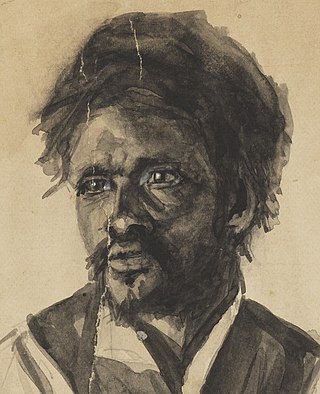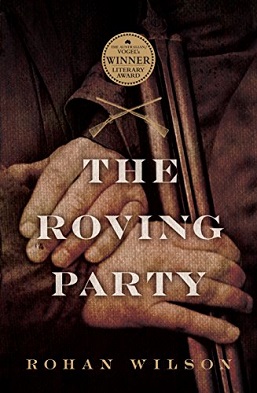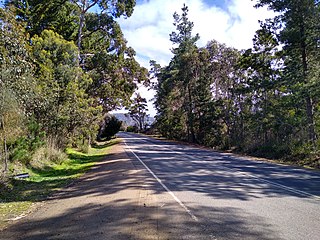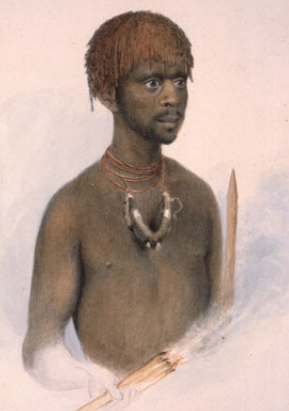
The Aboriginal Tasmanians are the Aboriginal people of the Australian island of Tasmania, located south of the mainland. At the time of European contact Tasmanian Aboriginals were divided into a number of distinct ethnic groups. For much of the 20th century, the Tasmanian Aboriginal people were widely, and erroneously, thought of as extinct and intentionally exterminated by white settlers. Contemporary figures (2016) for the number of people of Tasmanian Aboriginal descent vary according to the criteria used to determine this identity, ranging from 6,000 to over 23,000.

Truganini, also known as Lalla Rookh and Lydgugee, was a woman famous for being widely described as the last "full-blooded" Aboriginal Tasmanian to survive British colonisation. Although she was one of the last speakers of the Indigenous Tasmanian languages, Truganini was not the last Aboriginal Tasmanian.

George Augustus Robinson was a British-born colonial official and self-trained preacher in colonial Australia. In 1824, Robinson travelled to Hobart, Van Diemen’s Land, where he attempted to negotiate a peace between European settlers and Aboriginal Tasmanians prior to the outbreak of the Black War. He was appointed Chief Protector of Aborigines by the Aboriginal Protection Board in Port Phillip District, New South Wales in 1839, a position he held until 1849. He is also remembered today for his role in the supply of Aboriginal remains to English 'collectors'.

The Black War was a period of violent conflict between British colonists and Aboriginal Tasmanians in Tasmania from the mid-1820s to 1832. The conflict was fought largely as a guerrilla war by both sides; some 600 to 900 Aboriginal people and more than 200 British colonists died.

Mount Nelson is a mountain suburb located on the southern boundary of the city of Hobart, Tasmania, Australia. Positioned to the south of Hobart's CBD, Mount Nelson offers panoramic views of the scenic Derwent estuary and surrounds. With an estimated resident population of 2,766 as of 2022, Mount Nelson contains a population density of 421.7 persons per square kilometre.

Musquito was an Indigenous Australian resistance leader, convict hunter and outlaw based firstly in the Sydney region of the British colony of New South Wales and later in Van Diemen's Land.

Tasmanian Gothic is a genre of Tasmanian literature that merges traditions of Gothic fiction with the history and natural features of Tasmania, an island state south of the main Australian continent. Tasmanian Gothic has inspired works in other artistic media, including theatre and film.
Colin Thomas Johnson, better known by his nom de plume Mudrooroo, was an Australian novelist, poet, essayist and playwright. His many works are centred on Aboriginal Australian characters and topics; however, there was some doubt cast upon his claims to have Aboriginal ancestry.

The Roving Party is a 2011 novel written by Tasmanian author Rohan Wilson. Wilson's first book, it is published by Allen & Unwin. The Roving Party won the 2011 Vogel Award. The novel was also shortlisted for the 2011 Victorian Premier's Literary Awards Vance Palmer Prize for Fiction.
The British colonisation of Tasmania took place between 1803 and 1830. Known as Van Diemen's Land, the name changed to Tasmania, when the British government granted self-governance in 1856. It was a colony from 1856 until 1901, at which time it joined five other colonies to form the Commonwealth of Australia. By the end of the colonisation in 1830 the British Empire had annexed large parts of mainland Australia, and all of Tasmania.

Eastern Tasmanian is an aboriginal language family of Tasmania in the reconstruction of Claire Bowern.
Bruny Island Tasmanian, or Nuenonne ("Nyunoni"), a name shared with Southeast Tasmanian, is an Aboriginal language or pair of languages of Tasmania in the reconstruction of Claire Bowern. It was spoken on Bruny Island, off the southeastern coast of Tasmania, by the Bruny tribe.

Luggenemenener was an early nineteenth-century Tasmanian Aborigine woman, who lived in the early 1800s. She endured the Black Wars and risked her life to protect her young son from a genocide of her people. Her homeland was in north-east Tasmania's Ben Lomond region. According to the French explorer Nicolas Baudin, Tasmania was originally known as Lutruwita.

Eumarrah was an Aboriginal Tasmanian leader. He was active in resisting British colonisation during the 1820s and early 1830s, but was ultimately captured and used as a guide in operations tracking down and removing other Indigenous people.

Great Bay is a rural locality on Bruny Island in the local government area of Kingborough in the Hobart region of Tasmania. It is located about 18 kilometres (11 mi) north-east of the town of Alonnah, the largest town on the island. The 2016 census determined a population of 57 for the state suburb of Great Bay. The Bruny Island Airport is located within the suburb of Great Bay.

Montpelliatta was a leader of the 'Big River' group of Aboriginal Tasmanian clans during the Black War of the 1820s and early 1830s in Tasmania. He is regarded as one of the main organisers of Aboriginal resistance to British colonisation during this period.

Kikatapula was a leading Indigenous figure during the British invasion and colonisation of Van Diemen's Land, later known as Tasmania. Also called Kickerterpoller or Black Tom Birch, he spent part of his youth living with the colonists, learning English and being baptised as a Christian. During the 1820s, he withdrew from British ways, and became a feared and formidable leader of Indigenous resistance during the early stages of the Black War.

Maulboyheenner was an Indigenous Australian resistance fighter and guide from north-eastern Tasmania. He was also known by several other names including Timme, Timmy, Bob and Malapuwinarana.

The Wybalenna Aboriginal Establishment was an internment facility built at Flinders Island by the colonial British government of Van Diemen's Land to accommodate forcibly exiled Aboriginal Tasmanians (Palawa). It was opened in 1833 and ceased operations in 1847. During that period around 180 Palawa were situated at Wybalenna with approximately 130 people dying at the establishment. Around another 25 died while being transported to the facility. The main commandant of Wybalenna was George Augustus Robinson who played a principal role in the system of capturing and sending Palawa to the facility. Famous people incarcerated at Wybalenna included Truganini, Mannalargenna and William Lanne, amongst others. Due to the many deaths of Indigenous people at Wybalenna, the alienation of the inmates from their homeland and the forcible repression of cultural practices, the Wybalenna establishment is regarded as an example of the implementation of genocidal policies against Indigenous Australians.
















